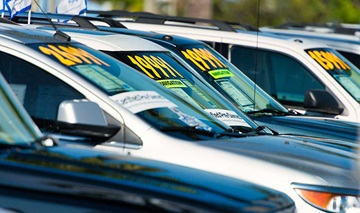Quand devez-vous laisser l’interrupteur de déconnexion de la batterie du VR en marche?
Your RV may come with this curious switch, and it’s not always immediately clear whether you should turn it off or on.
What Does the RV Battery Disconnect Switch Do?
Turn on the RV battery disconnect switch to connect your house batteries to the RV. Turn it off to cut your batteries from the rest of the circuit.
Your RV battery disconnect switch will be located somewhere near the battery compartment in your fifth wheel or motor home. The switch can sever the power connection between the 12-volt RV batteries in the house bank and the rest of the RV. Why would you do that?
Long periods of sitting can drain your house batteries (the same way long periods of sitting will drain a car battery) until they’re so dead they can’t recharge. Clicking the RV battery disconnect switch will keep your house batteries from discharging faster than usual.
New Batteries Bring Your RV to Life.
Visit your nearest Interstate All Battery Center for a long-lasting RV battery out of a wide-ranging selection of deep cycle batteries and battery expertise.
All batteries, lithium to lead-acid to alkaline, discharge themselves. It’s a slow process. It speeds up if they’re connected to a circuit that uses any power at all. That includes any 12-volt appliances in your RV and the operating controls for your 110-volt appliances such as the fridge and air conditioning. A single indicator light could drain those house batteries in a week.
So, turn off the RV battery disconnect switch to cut the house batteries from the circuit.
How Long Do RV Batteries Last When They’re Not Used?
Most flooded lead-acid batteries self-discharge at about 3%-5% per month. An absorbed glass-mat battery, such as the 34M-AGM dual-purpose battery, has a discharge rate of about 1%-2% a month.
That doesn’t mean you can let them sit until they drain to 0% before you worry about recharging.
All lead-acid batteries can be damaged if they sit discharged for any length of time. Even deep-cycle batteries, designed to drain deeply, shouldn’t stay discharged for days. If they do, their internal components can harden and get stuck in the discharged position through a process called sulfation. Normally, you don’t need to worry about this. The alternator will recharge the house batteries as you drive, if you leave the RV battery disconnect switch on.
Test Your Motorhome Batteries Before Hitting the Road
Visit any location where Interstate is sold to get an accurate battery analysis. They can even test a whole battery bank and pinpoint weak batteries before they fail.
Starting batteries should never be drained past 75%. That means they can sit disconnected for five to six months before permanent damage occurs. AGM batteries can sit unused longer, but that time can still reduce how much power they hold.
What Could I Do to Protect My RV Batteries in Summer?
Charge your RV batteries every chance you can.
Some batteries, like your phone battery, are fine with being half-charged. Lithium batteries love being less than 100%. NiCd batteries hate staying on the battery charger. Lead-acid batteries, on the other hand, need power.
Your RV batteries need to stay at 100% state of charge when they’re not active, or else their internal components harden and stop conducting electricity. That’s the process called sulfation, as in the lead-sulfate crystalizes instead of being separated into lead-acid again by electricity.
When you’re driving, the RV’s alternator will charge the house batteries. Just make sure you don’t use the RV battery disconnect switch before hitting the road. That switch cuts the house batteries from the RV and is primarily for safety when changing out the house battery pack. Otherwise, you can charge the batteries with a smart charger. Remember, even if your batteries are not in use, they’ll slowly lose charge. Keep them on a charger whenever you can.
Wear your love for Interstate Batteries on your sleeve.
Check out our store for camo hats, cups and more Outrageously Dependable gear from Interstate Batteries.
To get the most life out of the deep cycle batteries in your house battery pack and the starting battery in the engine, keep your batteries fully charged.
Keep your RV batteries in the shade and away from the heat.
Your RV batteries are rated to handle the extreme temperatures in a car engine. That doesn’t mean you should leave them there. High temperatures can cause water to evaporate from the electrolyte and hurt the battery. Lead-acid batteries have a carefully designed chemical mixture of sulfuric acid and water. If temperatures get hot enough, the water can turn into water vapor and leave the battery. Battery chargers use special algorithms to keep batteries from becoming too hot while charging.
If you have a flooded, deep cycle battery like the SRM-24 battery, you should check the water level occasionally by opening the vent caps. The water level should be above the lead plates. If it’s not three-fourths of an inch above the plates, add distilled water.
Use a corrosion preventative spray to protect RV batteries.
If your morning coffee depends on a healthy set of house batteries, then there are two RV battery cleaning products you should keep on hand: corrosion cleaner and corrosion preventative.
Corrosion is natural for batteries. It means electricity is passing through the metal, causing it to be a bit reactive to the environment. Chemistry works faster in high temperatures, though. Left unchecked, corrosion can eat into your terminals and clamps. That’s why it’s important to give your house batteries a monthly cleaning and preventative spray.
Go to the Battery Experts to Keep Your Batteries Going.
From corrosion cleaners to connection supplies, the team at your nearest Interstate All Battery Center can connect you to everything you need to keep your RV batteries healthy.




